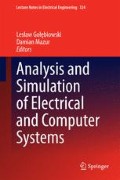Abstract
In the paper all three and five periodic orbits of certain (known and a bit less known) quadratic and cubic polynomials as well as polynomials of order greater than 4 are generated. Other periodic orbits are also discussed here. The basic polynomials considered in this paper are the minimal polynomials of \(2\mathop {\cos } \frac{2\pi }{2n - 1}\) or \(2\mathop {\sin } \frac{2\pi }{2n - 1}\) for every \(n = 4,5,6,7,8\). The concept of n-periodic trigonometric orbits is introduced. Also generalizations of Benedetto identities are presented.
Access this chapter
Tax calculation will be finalised at checkout
Purchases are for personal use only
References
Benedetto R (2001) An elementary product identity in polynomial dynamics. Am Math Mon 108:860–864
Mason JC, Handscomb DC (2003) Chebyshev polynomials. Chapman & Hall/CRC, Boca Raton
Rivlin TJ (1990) Chebyshev polynomials from approximation theory to algebra and number theory. Wiley, New York
Paszkowski S (1975) Numerical applications of Chebyshev polynomials and series. PWN, Warsaw (in Polish)
Wituła R, Complex numbers, polynomials and partial fraction decomposition, vols I and II. Wydawnictwo Politechniki Śląskiej (2010) (in Polish)
Wituła R, Słota D (2006) On modified Chebyshev polynomials. J Math Anal Appl 324:321–343
Tričković SB, Stanković MS (2004) On periodic solutions of a certain difference equation. Fibonacci Q 42:300–305
Wituła R, Słota D (2009) Fixed and periodic points of polynomials generated by minimal polynomials of 2 cos (π/n). Int J Bifur Chaos Appl Sci Eng 19:3005–3016
Hetmaniok E, Lorenc P, Słota D, Wituła R (in press) Periodic orbits of boundary logistic map and new kind of modified Chebyshev polynomials. In: Monograph on the occasion of 100th birthday anniversary of Zygmunt Zahorski, R. Wituła, D. Słota, W. Hołubowski (eds.), Wyd. Pol. Śl., Gliwice.
Trawiński T, Kołton W, Hetmaniok E, Słota D, Wituła R (2013) Analysis of Chaotic phenomena occurring in chosen branched kinematic chains of robot manipulators. In: Wybrane Zagadnienia Elektrotechniki i Elektroniki, pp 1–8. Czarna
Wituła R (2011) Formulae for sums of unimodular complex numbers. WPKJS, Gliwice (in Polish)
Wituła R, Słota D (2009) Decomposition of certain symmetric functions of powers of cosine and sine functions. Int J Pure Appl Math 50:1–12
Wituła R, Słota D (2007) New Ramanujan-type formulas and quasi-fibonacci numbers of order 7. J Integer Seq 10 (Article 07.5.6)
Wituła R, Słota D (2007) Quasi-fibonacci numbers of order 11. J Integer Seq 10 (Article 07.8.5)
Wituła R, Słota D (2010) Quasi-fibonacci numbers of order 13 on the occasion of the thirteenth international conference on fibonacci numbers and their applications. Congr Numer 201:89–107
Baker IN (1960) The existence of fixpoints of entire functions. Math Z 73:280–284
Baker IN (1964) Fixpoints of polynomials and rational functions. J London Math Soc 39:615–622
Pezda T (1994) Cycles of polynomials in algebraically closed fields of positive characteristic. Colloq Math 67:187–195
Pezda T (1996) Cycles of polynomials in algebraically closed fields of positive characteristic II. Colloq Math 71:23–30
Hacibekiro\({\tilde{\text{g}}}\)lu G, Ca\({\tilde{\text{g}}}\)lar M, Polato\({\tilde{\text{g}}}\)lu Y (2009) The higher order Schwarzian derivative: its applications for chaotic behavior and new invariant sufficient condition of Chaos. Nonlinear Anal Real World Appl 10:1270–1275
Devaney RL (1989) An introduction to chaotic dynamical systems. Addison-Wesley, Boston
Gulick D (2012) Encounters with Chaos and fractals. CRC Press, Boca Raton
Kwietniak D, Oprocha P (2008) Chaos theory from the mathematical viewpoint. Mat Stosow 9:1–45 (in Polish)
Li TY, Yorke JA (1975) Period three implies Chaos. Am Math Mon 82:985–992
Ciesielski K, Pogoda Z (2008) On ordering the natural numbers or the Sharkovski theorem. Am Math Mon 115:159–165
Du BS (2007) A simple proof of Sharkovsky’s theorem revisited. Am Math Mon 114:152–155
Elaydi SN (2005) An introduction to difference equations. Springer, New York
Misiurewicz M (1997) Remarks on Sharkovsky’s theorem. Am Math Mon 104:846–847
Dunlap R (2006) The golden ratio and fibonacci numbers. World Scientific, Singapore
Hsu C-H, Li M-C (2002) Transitivity implies period six: a simple proof. Am Math Mon 109:840–843
Vellekoop M, Berglund R (1994) On intervals, transitivity = Chaos. Am Math Mon 101:353–355
Kuipers L, Niederreiter H (1974) Uniform Distribution of Sequences. Wiley, New York
Author information
Authors and Affiliations
Corresponding author
Editor information
Editors and Affiliations
Rights and permissions
Copyright information
© 2015 Springer International Publishing Switzerland
About this paper
Cite this paper
Wituła, R., Hetmaniok, E., Słota, D., Trawiński, T., Kołton, W. (2015). On the Three, Five and Other Periodic Orbits of Some Polynomials. In: Gołębiowski, L., Mazur, D. (eds) Analysis and Simulation of Electrical and Computer Systems. Lecture Notes in Electrical Engineering, vol 324. Springer, Cham. https://doi.org/10.1007/978-3-319-11248-0_8
Download citation
DOI: https://doi.org/10.1007/978-3-319-11248-0_8
Published:
Publisher Name: Springer, Cham
Print ISBN: 978-3-319-11247-3
Online ISBN: 978-3-319-11248-0
eBook Packages: EngineeringEngineering (R0)

